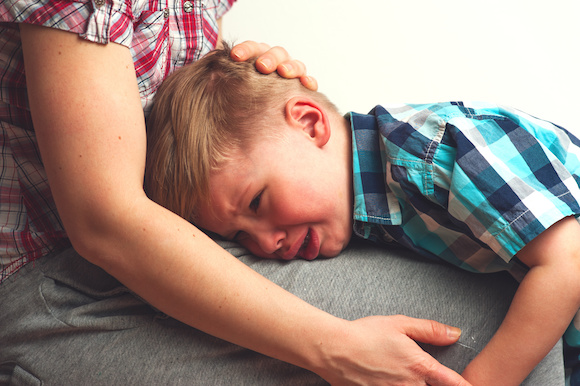
Most of us are taken aback when our child lashes out after a particularly nice time together. What on earth?
But it's precisely BECAUSE we connected with our child that he's showing us his pain.
If that seems crazy, consider this from your child's perspective. Before this warm interaction, when your child had a rough patch, he may have experienced some jealousy, anger, and other feelings he didn't feel comfortable expressing. So he stuffed those feelings in his emotional backback.
We all have an emotional backpack, which is the unconscious (aka the body.) When we can't process a big feeling, we stuff it in the emotional backpack and lug it around until we find a safe opportunity to work through it. Once we allow ourselves to feel those stored up emotions, their message is delivered, and they melt away.
But in the meantime, while the child is struggling with a full emotional backpack, these painful emotions disconnect children from us, so they can't take in the love we're offering. They become difficult and contrary, because they're miserable.
Then, when we initiate closeness, it's like getting what they've been longing for. It brings up all their pent-up need for us -- but all those angry, sad or scared feelings are in the way!
So after some nice snuggling or giggling, your child may begin to cry or even lash out. That doesn’t mean you’ve done anything wrong. It means that your child wants to accept the love you’re offering, and needs your help to let go of those upset feelings that are in his way, before he can connect with you.
Let's look at what happened with Katie's son, mentioned in the question above.
- He often seems angry since his brother was born. Inside, he's feeling sad and alone, worried about whether his mom still loves him.
- He loved snuggling and giggling with his mom.
- By restoring that loving connection, Katie helped her son feel safe enough to show her the upset feelings he's been struggling with since his brother was born. Unfortunately, he showed her those feelings by hitting her!
- Katie stayed calm. She didn't yell or punish. She stopped her son from hitting. She acknowledged his anger.
- Katie's understanding helped her son feel safe enough to go under the anger to the sadness and fear that were causing the anger.
- He cried, showing his mom the depth of his pain.
Katie was taken aback. Why is he hitting and crying, when she's trying to have a loving interaction? But in fact, it is precisely her love that was healing to her son. Love isn't just about those warm, snuggly moments. Love is also sitting with our child while he shares his deep despair. Love accepts our child, difficult emotions and all. Love heals.
The good news? After showing his mom how he felt, and having her understand, this little boy is feeling much happier and more cooperative. Their relationship is closer. He doesn't feel so much resentment toward the baby. He's more cooperative with his mom.
This is one of the great benefits of connection time with our kids. The child starts to reconnect with us at a deeper level. They show us what’s happening, and ask for our help to work it through. Sometimes they work out the tension through play. Sometimes they begin talking about the upset, which gives us a chance to empathize and say how sorry we are that it's been so hard.
Or sometimes, they show us how they're feeling by hitting. That's unacceptable, of course. But it's the action that's unacceptable, not the feeling. Notice what Katie did here. She didn't push her son away or shut down his feelings. Even while she set a limit -- "I won't let you hit me" -- she reconnected. She held his hand and acknowledged his feelings. That empathy helped him feel safe enough to cry.
You might say, with understanding, "Ouch! All of a sudden you seem very angry. I won't let you hurt me, but you can show me how mad you are, by pushing my hands.... and you can tell me in words. I'm listening."
Then just listen, whether your child is using words, tears, or pushing to express his feelings. He may well want to struggle against you, which helps kids get past the anger to the fear beneath. If you can stay compassionate, and really feel it from his perspective, you'll probably tear up. That's a good thing -- your emotional resonance with what he's feeling makes it safer for your child to cry and feel those uncomfortable emotions. And that's where the real healing comes.
Like Katie's son, after he cries, you'll find that your child is relieved, much happier and more connected to you.
And ready for that loving snuggle!





